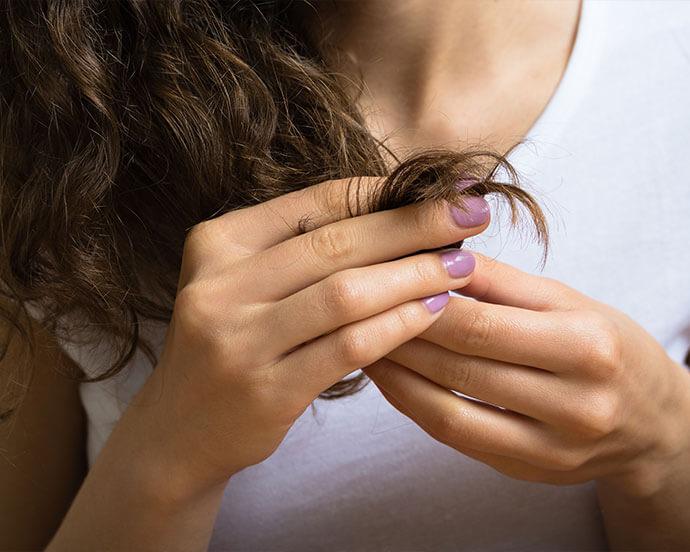What Does Damaged Hair Look Like? A Trichologist Shares 4 Telltale Signs



Hannah Cassidy


Photo by iprogressman / Getty Images
Sometimes it feels like our hair is happy, healthy, and hydrated, and the next day we’re in a mess of dryness, split ends, and (gasp) breakage. Notwithstanding extreme cases like DIY bleach jobs gone awry, there’s a good chance the damage didn’t happen overnight and, in fact, the signs were probably there the whole time. But what does damaged hair look like, exactly?
We asked trichologist Gretchen Friese for expert tips on identifying different signs of damaged hair (yes, there’s more than one), treating them, and the preventative measures we can take to stop the vicious hair damage cycle.


It's about glam time you treated yourself.
MEET THE EXPERT
Gretchen Friese is a Colorado-based professional hairstylist and trichologist specializing in hair loss.
4 Signs You Might Have Damaged Hair:
1. Damaged Hair That Feels Dry and Brittle
While hair damage can show up in a number of ways, the first clue is usually a change in hydration levels and hair texture—when hair begins to feel drier or more brittle than usual. “Some people are born with naturally dry, brittle hair. But it is usually a result of a lack of moisture,” explains Friese, adding that the most common culprits are excessive heat styling (which removes moisture from the hair), incorrect hair care products for your hair type, or a diet that lacks essential nutrients like omega-3 fatty acids and biotin.
To treat dry and brittle hair, Friese recommends adding in a healthy dose of moisture: “Use a moisturizing shampoo and conditioner with a moisturizing mask.” Try swapping your go-to shampoo and conditioner for a set that contains ingredients that are known to help hydrate and nourish, like glycerin, butters, oils, and fatty alcohols. “Leave-in treatments are a good idea as well and always use heat protection when styling with heat,” adds Friese. So if you’re regularly using flat irons, curling irons, or blow dryers, using a heat protectant is absolutely vital in maintaining healthy hair. We love DAE HAIR’s Cactus Flower Leave In Conditioner for a lightweight option that can be used daily and also offers heat protection up to 450 degrees—helping to curb heat damage.
2. Damaged Hair Can Look Dull or Brassy in Color
Another telltale sign of potentially damaged hair is when your color (natural or salon-made) loses its usual vibrancy and tonal value. Dull hair could be the by-product of dryness, product buildup, or artificial hair colors beginning to fade. Luckily, the remedies for this are fairly straightforward. For brassiness, Friese recommends using a hair color toner or color-depositing purple or blue shampoo—like IGK HAIR’s Blonde Pop Purple Toning Shampoo that quickly neutralizes brassy tones in blonde hair.
If you suspect your dullness is being caused by dryness or product buildup, Friese suggests using a clarifying shampoo to help remove the buildup and a deep conditioning treatment to restore hair health and shine. This combo can be repeated periodically to help maintain your hair’s luster.
3. Damaged Hair Tangles Easily
Tangles are par for the course when styling your hair, but how can you tell if your hair is tangling more than normal? If you can’t get a brush or fingers through your hair, you might be dealing with not only existing hair damage but additional damage if you don’t deal with your tangles correctly. “Tangled hair can break more easily and even possibly get pulled out of the follicle,” says Freise. “Use a detangling product, make sure to brush the hair often, make sure to keep the hair moisturized, and wear protective hairstyles (especially to bed).”
The type of brush you’re using can also make a world of difference. “If you are brushing out wet hair, I recommend using a wide-tooth comb or wet brush to help prevent breakage of the fragile wet hair. If you are brushing out dry hair use something that has a boar bristle because it will be gentler on the cuticles than plastic bristles,” Friese tells us. Opt for a boar-nylon hybrid brush like The Brush No. 001 from CROWN AFFAIR or splurge for a full boar bristle brush—the BEAUTÉ hairbrush Gentle Detangling from ALTESSE STUDIO is designed to gently maneuver through tight tangles without breakage.
4. Damaged Hair Has Split Ends or Breakage
Hair breakage can be the most harrowing manifestation of damage, and the causes are either chemical damage or mechanical (the use of hot tools), says Friese. And the best way to prevent hair breakage is to protect and strengthen—especially if your hair is on the finer side. “Fine hair is more prone to breakage because it has a thinner cuticle layer and does not have as much keratin (protein) as thicker hair,” explains Friese, who recommends using products that contain keratin or strengthening properties. “Also, use heat protection and if you color your hair (especially highlighted hair) make sure not to overlap the color—I recommend always seeing a professional in this case,” Friese adds.
For split ends, regular trims to the ends of your hair is the best way to nip further damage in the bud. “Split ends need to be cut off of the hair. This is the only true way to get rid of them and prevent further hair breakage,” says Friese.
Final Thoughts
Damaged hair doesn’t have to be a permanent struggle. By recognizing the signs early—whether it’s dryness, tangles, or breakage—and taking the right steps to treat and protect your hair, you can restore its health and vitality. Consistency is key, so build a routine that works for you and watch your hair bounce back stronger than ever.
Liked this post? Share!
Related Stories


Hair
6 Hair Trends Set to Take Over in 2026, From Bixie Cuts to Bouncy Blowouts
Published on Dec 5, 2025 • 5 min read


Hair
21 Easy Hairstyles to Enhance Your Natural Curls and Coils
Published on Dec 3, 2025 • 11 min read


Hair
The Ultimate Guide to Styling Short Hair
Published on Dec 1, 2025 • 11 min read


Hair
From Bangs to Blonde: The Hair Trends Taking Over 2025
Published on Dec 16, 2024 • 5 min read


Hair
Scalp Exfoliation Is the Key to Healthier Hair—Here’s How to Do It Correctly
Published on Nov 21, 2025 • 9 min read


Hair
The 10 Best Hair Masks and Conditioners to Promote Hair Growth
Published on Mar 11, 2024


Hair
20 Trendy Hairstyles That’ll Make You the Life of the (Holiday) Party
Published on Oct 15, 2025 • 9 min read


Hair
Easy Thanksgiving Hairstyles to Look Polished While You Feast
Published on Oct 2, 2025 • 6 min read


Beauty Picked Just for You
Get 5 products worth up to $70
Plus exclusive access to epic deals up to 80% off
Starting at just $14/month. Cancel anytime.